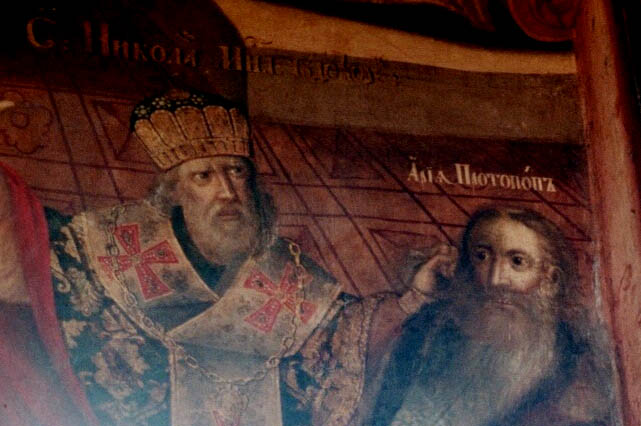
Nicholas of Myra punching Bishop Arius at the Council of Nicaea
The birth of Jesus Christ may be the “reason for the season,” but for millions of children the man of the moment is Santa Claus.
While it’s widely known that the Santa Claus of Christmas is derived from St. Nicholas, few know much about the original Saint Nick beyond the fact that he did not actually live at the North Pole, own flying reindeer, or employ a workshop full of elves.
Nicholas was a political ally of Athanasius of Alexandria during the Church intrigues of the 4th Century that led to Trinitarianism. And, like Athanasius, he is rumored to have come into power at an absurdly young age through dubious means.
Fast Track to Bishop
The legend begins with Nicholas as a young man on his way back home to Asia Minor (what we now call Turkey) either from studying at Alexandria in Egypt or from visiting Jerusalem. While still at sea, as the tale goes, he rescued a sailor who had fallen overboard. Or, perhaps he calmed a sea storm with his prayers. To put it mildly, the stories differ.
But, in all of the stories, Nick’s ship then made port in the city of Myra.
Just before Nicholas arrived, the bishop of Myra had died and one of the city’s church leaders claimed to have had a dream that instructed him to choose a “conqueror” as the next bishop. You or I might be suspicious of such a claim, or such an an instruction. The church leaders of Myra were not so cynical, and they took the dream as direction from God.
Now, the root of the name Nicholas (Νικόλαος) is the Greek word nike, meaning “conquest” or “victory.” So, when sailors who were astounded at the exploits of this newly arrived youth spread the name Nicholas around Myra, the leaders of the church decided they had no choice but to elect the young Nicholas as bishop.
Saint to Santa
Long after the death of Nicholas of Myra, the character of Saint Nicholas was adapted by the Dutch as the gift-giving Sinterklaas, and brought him across the Atlantic to New Amsterdam, now New York City. After the Revolution, the European Sinterklaas evolved into the American Santa Claus at the hands of civic-minded folk like Washington Irving.
The Christmastide gift-giving traditions ascribed to Old St. Nick may be through association with the Three Magi, or absorbed from the cult of the Greek St. Basil, a renowned gift-giver and alternate Father Christmas whose feast day is on the 1st or 2nd of January. Like the circumstances surrounding his rise to power, the generosity of Nicholas is a matter of dispute and legend.
The Darker Side
What is not disputed, however, is the alliance of Bishop Nicholas with the disruptive conflationist party led by Athanasius of Alexandria, a network of corrupt and violent bishops described as an “ecclesiastical mafia” by scholar of the early church Timothy Barnes.
While Nicholas was not involved in the embezzlement, cronyism, fraud, slander, and murder committed by the Alexandrians themselves, he was certainly a key player in their courting of Imperial power and usurpation of Christian theology through violence and intimidation.
By one account of the Council of Nicaea—convened by the still-pagan Emperor Constantine at the urging of a fringe bishop named Hosius—Nicholas became so frustrated by the testimony of Bishop Arius that he punched the old man in the face in front of the entire Council.
This emblematic act of violence typified the authoritarian conflationist movement, from the Council of Nicaea through their complete seizure of Imperial power under Emperor Theodosius, who issued an edict at Thessalonica making deviation from conflationist dogma punishable by death, a sentence that survived for centuries as a cherished tradition among Trinitarians.
Unable to succeed through reason and truth, they resorted to brute force.
Redemption of the Conqueror
Many Trinitarians today condemn the modern American manifestation of Saint Nick—reduced to a gift giving legend and accreting pagan imagery—as a syncretic and commercialized corruption of the Christian message, ironically ignorant of the violent and oppressive role Nicholas of Myra played in establishing their own Trinitarian corruption of the original Christian message.
However, from a Reform Unitarian perspective the gift-giving Santa Claus tradition redeems the sectarian Nicholas: by adapting imagery from European cultures to Christian purpose in the very model of the Three Wise Men, who were themselves—as Zoroastrian Magi—gift giving representatives of an outside religion and culture.
The “Jolly Old Elf” has also performed a useful, morally instructive function in Christian culture, providing young children a simple model of moral behavior they can understand at their immature stage of intellectual and moral development. Slamming the minds of young children with the sophisticated and painful realities of a full-blown Christian morality—based on facing the harsh reality of our condition as mortal creatures—would be traumatically inappropriate. Santa Claus represents a “pre-conventional” morality of rewards and punishments appropriate to younger minds and which can later be developed into more mature, post-conventional Christian worldview grounded in human mortality and the Golden Rule.
Of course, many who outgrow Santa Claus never outgrow the juvenile reward-and-punishment morality that the Man in Red represents, unable to mature beyond Christmastime religion to the bitter lessons of Gethsemane. But, over the centuries the role of Saint Nick in Christian culture and religion has matured from a pugnacious thug in the conflationist mob—eager to punish with violence anyone who resists—to an exemplar of ecumenical and educational virtue, from an emblem of ancient brutality and oppression to a modern symbol of joy, kindness, and generosity.
Although the consequences of that Nicene sucker punch still echo today … we forgive you, Nicholas.
